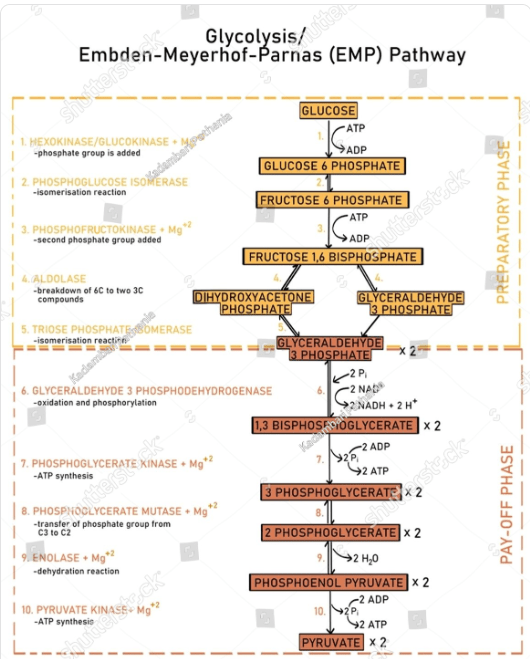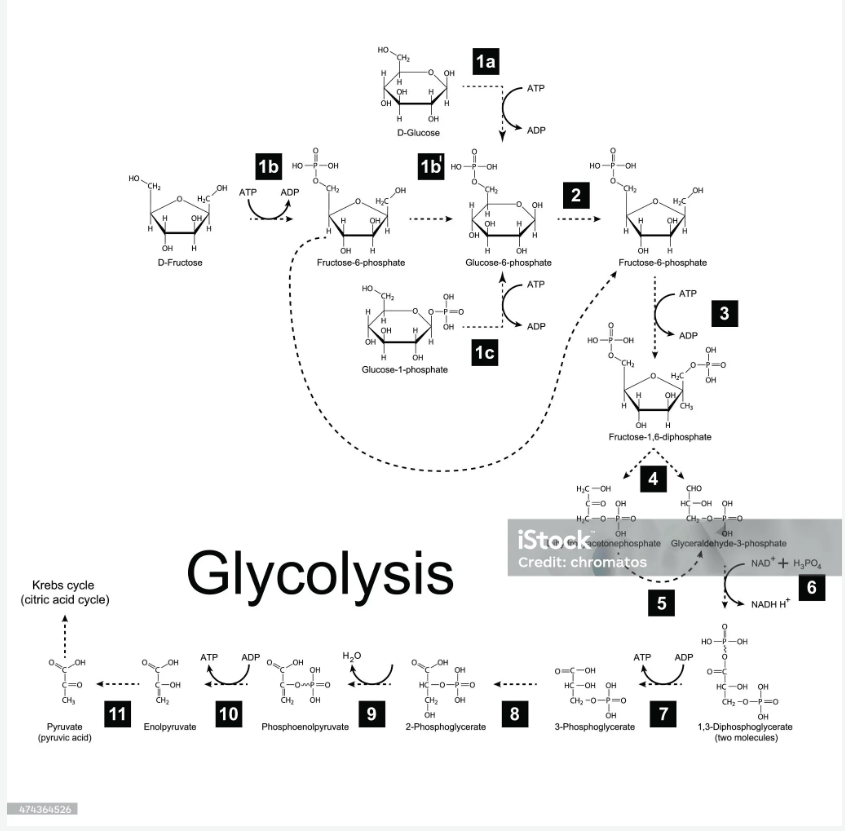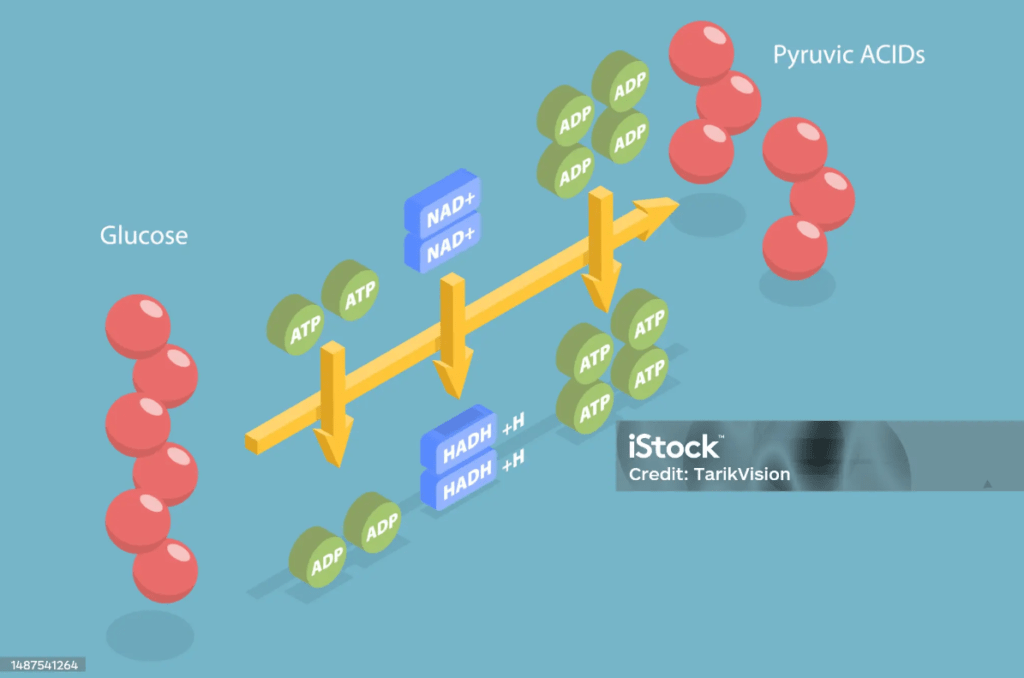Glycolysis is a metabolic pathway that converts glucose into pyruvate, releasing energy and forming the essential intermediate compounds needed for cellular respiration. It occurs in the cytoplasm of cells and consists of a series of ten enzyme-catalyzed reactions. Glycolysis can be divided into two main phases: the preparatory (investment) phase and the payoff phase.
Glycolysis is a ten-step metabolic pathway that converts glucose into pyruvate, generating ATP and NADH in the process. Here is a detailed, step-by-step overview of glycolysis:

The Energy-Requiring Phase/The Preparatory (Investment) Phase:
The energy-requiring phase of glycolysis, also known as the energy investment phase, consists of the first five steps of the glycolytic pathway. During this phase, two molecules of ATP are consumed to phosphorylate glucose and its intermediates. Here are the steps involved in the energy-requiring phase:
Step 1: Hexokinase Reaction
- Enzyme: Hexokinase
- Reaction: Glucose is phosphorylated to form glucose-6-phosphate (G6P).
- Equation: Glucose + ATP → Glucose-6-phosphate + ADP
- Significance: This step traps glucose in the cell and prepares it for further breakdown.
Step 2: Phosphoglucose Isomerase Reaction
- Enzyme: Phosphoglucose isomerase
- Reaction: Glucose-6-phosphate is converted into fructose-6-phosphate (F6P).
- Equation: Glucose-6-phosphate → Fructose-6-phosphate
- Significance: Isomerization makes the molecule more suitable for subsequent phosphorylation.
Step 3: Phosphofructokinase-1 (PFK-1) Reaction
- Enzyme: Phosphofructokinase-1 (PFK-1)
- Reaction: Fructose-6-phosphate is phosphorylated to form fructose-1,6-bisphosphate (F1,6BP).
- Equation: Fructose-6-phosphate + ATP → Fructose-1,6-bisphosphate + ADP
- Significance: This is a key regulatory step in glycolysis, committing the molecule to further breakdown.
Step 4: Aldolase Reaction
- Enzyme: Aldolase
- Reaction: Fructose-1,6-bisphosphate is split into two three-carbon sugars: glyceraldehyde-3-phosphate (G3P) and dihydroxyacetone phosphate (DHAP).
- Equation: Fructose-1,6-bisphosphate → Glyceraldehyde-3-phosphate + Dihydroxyacetone phosphate
- Significance: Cleaves the six-carbon sugar into two three-carbon intermediates.
Step 5: Triosephosphate Isomerase Reaction
- Enzyme: Triosephosphate isomerase
- Reaction: DHAP is converted into another molecule of G3P.
- Equation: Dihydroxyacetone phosphate → Glyceraldehyde-3-phosphate
- Significance: Ensures that both molecules continue through glycolysis as G3P.
Summary of the Energy-Requiring Phase
- ATP Consumed: 2 ATP molecules (one in step 1 and one in step 3)
- Purpose: To phosphorylate glucose and its intermediates, making them more reactive and preparing them for the subsequent energy payoff phase.
- End Products: 2 molecules of glyceraldehyde-3-phosphate (G3P)
The energy investment phase is essential for priming the glucose molecule, ensuring that it can be efficiently broken down in the subsequent steps of glycolysis to produce ATP and other metabolites.

The Energy-Releasing Phase/The Payoff Phase:
The energy-releasing phase of glycolysis, also known as the energy payoff phase, consists of the last five steps of the glycolytic pathway. During this phase, energy stored in the intermediates is harvested in the form of ATP and NADH. Here are the steps involved in the energy-releasing phase:
Step 6: Glyceraldehyde-3-phosphate Dehydrogenase Reaction
- Enzyme: Glyceraldehyde-3-phosphate dehydrogenase
- Reaction: Each molecule of glyceraldehyde-3-phosphate (G3P) is oxidized, and inorganic phosphate (Pi) is added to form 1,3-bisphosphoglycerate (1,3-BPG). NAD+ is reduced to NADH.
- Equation: Glyceraldehyde-3-phosphate + NAD+ + Pi → 1,3-Bisphosphoglycerate + NADH + H+
- Significance: This step generates NADH, which carries high-energy electrons, and produces a high-energy intermediate.
Step 7: Phosphoglycerate Kinase Reaction
- Enzyme: Phosphoglycerate kinase
- Reaction: 1,3-Bisphosphoglycerate donates a phosphate group to ADP to form ATP and 3-phosphoglycerate (3PG).
- Equation: 1,3-Bisphosphoglycerate + ADP → 3-Phosphoglycerate + ATP
- Significance: This is the first step of substrate-level phosphorylation, directly generating ATP.
Step 8: Phosphoglycerate Mutase Reaction
- Enzyme: Phosphoglycerate mutase
- Reaction: 3-Phosphoglycerate is converted into 2-phosphoglycerate (2PG).
- Equation: 3-Phosphoglycerate → 2-Phosphoglycerate
- Significance: Prepares the molecule for subsequent dehydration.
Step 9: Enolase Reaction
- Enzyme: Enolase
- Reaction: 2-Phosphoglycerate is dehydrated to form phosphoenolpyruvate (PEP).
- Equation: 2-Phosphoglycerate → Phosphoenolpyruvate + H2O
- Significance: Produces a high-energy phosphate compound.
Step 10: Pyruvate Kinase Reaction
- Enzyme: Pyruvate kinase
- Reaction: Phosphoenolpyruvate donates its phosphate group to ADP to form ATP and pyruvate.
- Equation: Phosphoenolpyruvate + ADP → Pyruvate + ATP
- Significance: This is the second step of substrate-level phosphorylation, producing ATP and the final product, pyruvate.
Summary of the Energy-Releasing Phase
- ATP Produced: 4 ATP molecules (2 per G3P, since each glucose produces two G3P molecules)
- NADH Produced: 2 NADH molecules (one per G3P)
- End Products: 2 molecules of pyruvate (one per G3P)
- Net Gain: Since 2 ATP were consumed in the energy-requiring phase, the net gain is 2 ATP molecules per glucose.
Overall Summary of Glycolysis

- Total ATP Produced: 4 ATP (net gain of 2 ATP)
- Total NADH Produced: 2 NADH
- Total End Products: 2 pyruvate, 2 NADH, 2 ATP (net), and 2 H2O
The energy payoff phase is crucial for the production of ATP and NADH, which are essential for cellular energy and metabolism. ATP serves as the primary energy currency of the cell, while NADH carries high-energy electrons to the electron transport chain in aerobic respiration, leading to further ATP production.
- Inputs: 1 glucose, 2 ATP, 2 NAD+, 4 ADP, 2 Pi
- Outputs: 2 pyruvate, 2 NADH, 4 ATP (net gain of 2 ATP), 2 H2O, 2 H+
Glycolysis is a crucial metabolic pathway that provides cells with energy and metabolic intermediates, functioning both aerobically and anaerobically to ensure cellular survival and function.
- Net Production: 2 ATP, 2 NADH, and 2 pyruvate molecules per molecule of glucose.
- Overall Reaction:

This breakdown of glycolysis details how glucose is metabolized to produce energy and intermediate compounds necessary for further cellular processes.
Here is the tabular representation of ATP production during glycolysis under aerobic and anaerobic conditions:
| Condition | Total ATP Produced | Net ATP Gain | NADH Fate | Additional ATP from NADH | Net ATP Produced |
|---|---|---|---|---|---|
| Aerobic | 4 | 2 | Used in the ETC | 5-6 (2 NADH × 2.5-3 ATP) | 2+5 or 2+6 = 7 or 8 |
| Anaerobic | 4 | 2 | Used in fermentation | 0 | 2 |
- Total ATP Produced: Total ATP generated during glycolysis.
- Net ATP Gain: Net ATP after accounting for ATP consumed.
- NADH Fate: Utilization of NADH produced in glycolysis.
- Additional ATP from NADH: Additional ATP that can be produced from NADH in the electron transport chain (ETC) under aerobic conditions. No additional ATP is produced from NADH under anaerobic conditions due to fermentation.